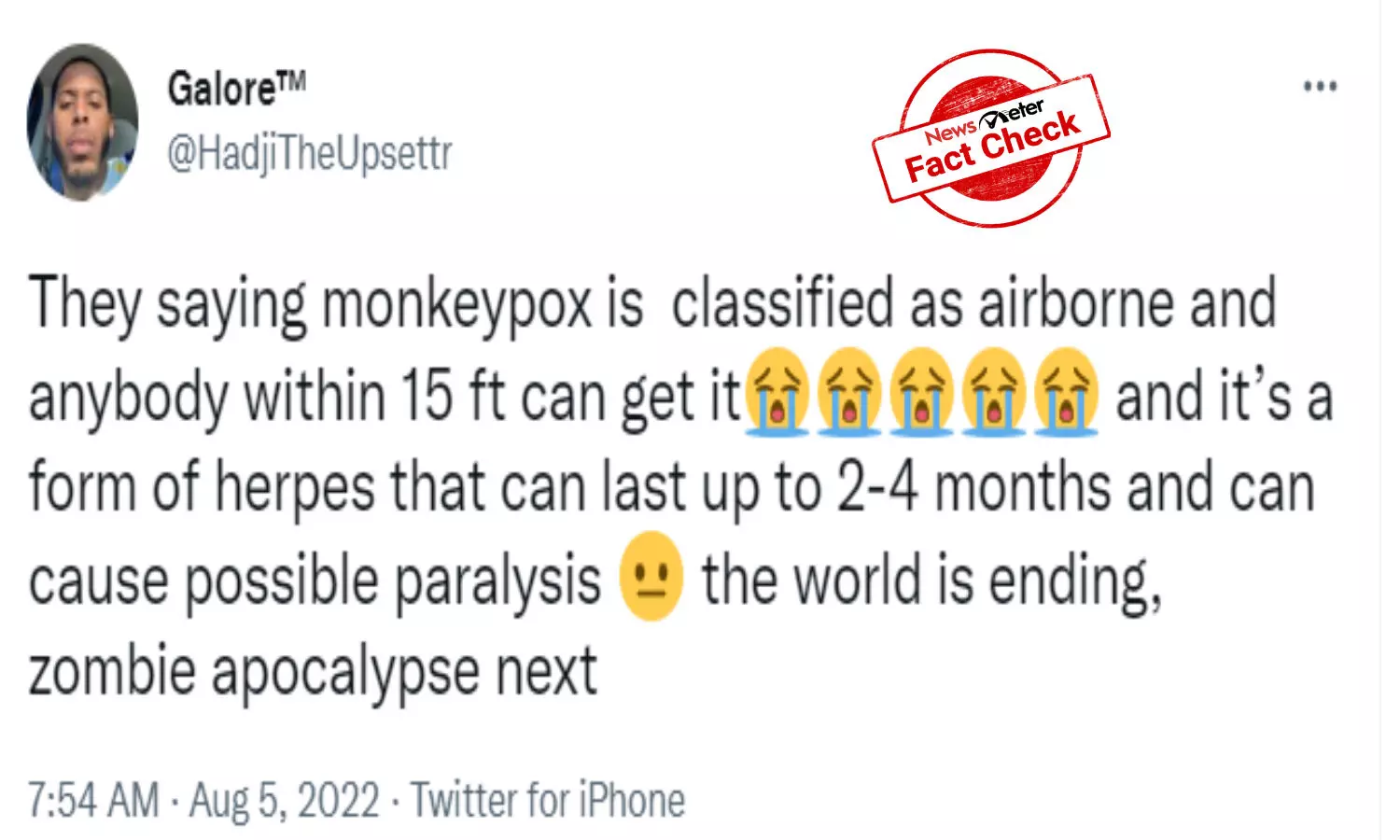Monkeypox is not airborne virus; viral claims are misleading
Social media users are claiming that ‘Monkeypox is an airborne virus'.
By Sunanda Naik
Social media users are claiming that 'Monkeypox is an airborne virus'.
Social media is full of misinformation about the disease.
Monkeypox outbreak was confirmed on May 22. India has also recorded a few cases to date.
They saying monkeypox is classified as airborne and anybody within 15 ft can get it😭😭😭😭😭 and it's a form of herpes that can last up to 2-4 months and can cause possible paralysis 😐 the world is ending, zombie apocalypse next
— Galore™ (@HadjiTheUpsettr) August 5, 2022
Continue to mask up #COVIDisAirborne and #monkeypox can be airborne too.
— Covid Report (@CovidDataReport) August 8, 2022
So Ontario universities... you are all really going to remove all public health measures on campuses and just let 'er rip... aren't you?
— Toronto: Please Vote! #ToryMustGo (@votefordoutnow) August 7, 2022
while we are facing down the twin barrels of #SARSCoV2 and #monkeypox which are AIRBORNE...#COVIDisAirborne #CovidIsntOver #highered #onpoli
We also found posts in which people want to know whether monkeypox is also an airborne virus like Covid-19.
So is Monkeypox airborne or not?
— Diana Zicklin Berrent (@dianaberrent) August 1, 2022
Fact check
Monkeypox is a viral infection stemming from the same family as the smallpox virus. It may indeed spread due to respiratory secretions like coughing and sneezing. But, is monkeypox an airborne disease? Let's debunk this myth.
NewsMeter referred World Health Organisation's website and found the mode of transmission. It says, 'Animal-to-human (zoonotic) transmission can occur from direct contact with the blood, bodily fluids, or cutaneous or mucosal lesions of infected animals'.
'Human-to-human transmission can result from close contact with respiratory secretions, skin lesions of an infected person, or recently contaminated objects.'
We didn't find monkeypox being an airborne virus anywhere.
https://www.who.int/news-room/
NewsMeter further performed a keyword search and found a report by the CDC that suggests, 'Monkeypox can be found in respiratory droplets like saliva that drop out of the air quickly, the CDC says. So far, the airborne transmission of monkeypox has not been confirmed.'
Monkeypox virus is a completely different virus from the viruses that cause COVID-19 or measles. It is not known to linger in the air and is not transmitted during short periods of shared airspace.
https://www.cdc.gov/media/
NewsMeter contacted experts who debunked the reports that monkeypox is an airborne virus.
Dr. P. Raghuramulu, Senior Consultant Physician &Diabetologist, Renova_NIGL Hospitals.
Monkey Pox was Isolated in 1950 from West Africa. It is an Orthopox Virus a genus of Small Pox Virus.
It spreads mainly through close physical contact with an infected person (not with sex) and Fomites (Infected Lenin & clothes) rarely prolonged contact with animals like Monkeys or eating infected animal meat(wild animals). It doesn't spread via Air, but someone in close contact with an infected person within a 2-meter distance for more than 3 hours can spread via large droplets. Can be Prevented by Isolation for 3 to 4 weeks till all the scab falls and with Small Pox Vaccination. The incubation period is mainly 5 to 13 days, (the maximum period is 4 to 21 days).
Symptoms start with Fever, Headache, body pains, and lymph nodal swelling, Rash appears within 4 days of fever. The rash is Painful & itchy typically spreads from the Face, Palms & soles, Rash is similar to Small Pox. It is not severe and self-limiting for normal persons. In severe cases, Antiviral drugs like Cidofovir or Ticoviramal may be useful.
Dr. Naresh Gundapuneni, Consultant General Physician, Renova Hospitals
Human-to-human transmission is known to occur primarily through large respiratory droplets generally requiring prolonged close contact. It can also be transmitted through direct contact with body fluids or lesion material, and indirect contact with lesion material, such as through contaminated clothing or linens of an infected person.
Animal-to-human transmission: may occur by bite or scratches of infected animals like small mammals including rodents (rats, squirrels) and non-human primates (monkeys, apes), or through bush meat preparation.
Hence, it is evident that the post is misleading.